Design and power quality analysis of hybrid renewable energy system for Tho Chu island, Viet Nam
Using renewable energy sources for providing electricity in remote
area is an economical-technical solution and reduces environmental pollution. Tho
Chu island, Phu Quoc district, Kien Giang province, is currently supplied by diesel
generators, causing environmental pollution and high-power generation costs. This
article presents hybrid renewable energy system (HRES) design including diesel
generator, photovoltaic system and energy storage system for Tho Chu Island. In
addition to calculating and selecting of equipment, ensuring power supply for the
load, the paper also examines the frequency and voltage quality, considers the
harmonic distortion of the power supply system. The simulation results obtained
from PYsyst and Matlab/Simulink software show the effectiveness of the HRES.
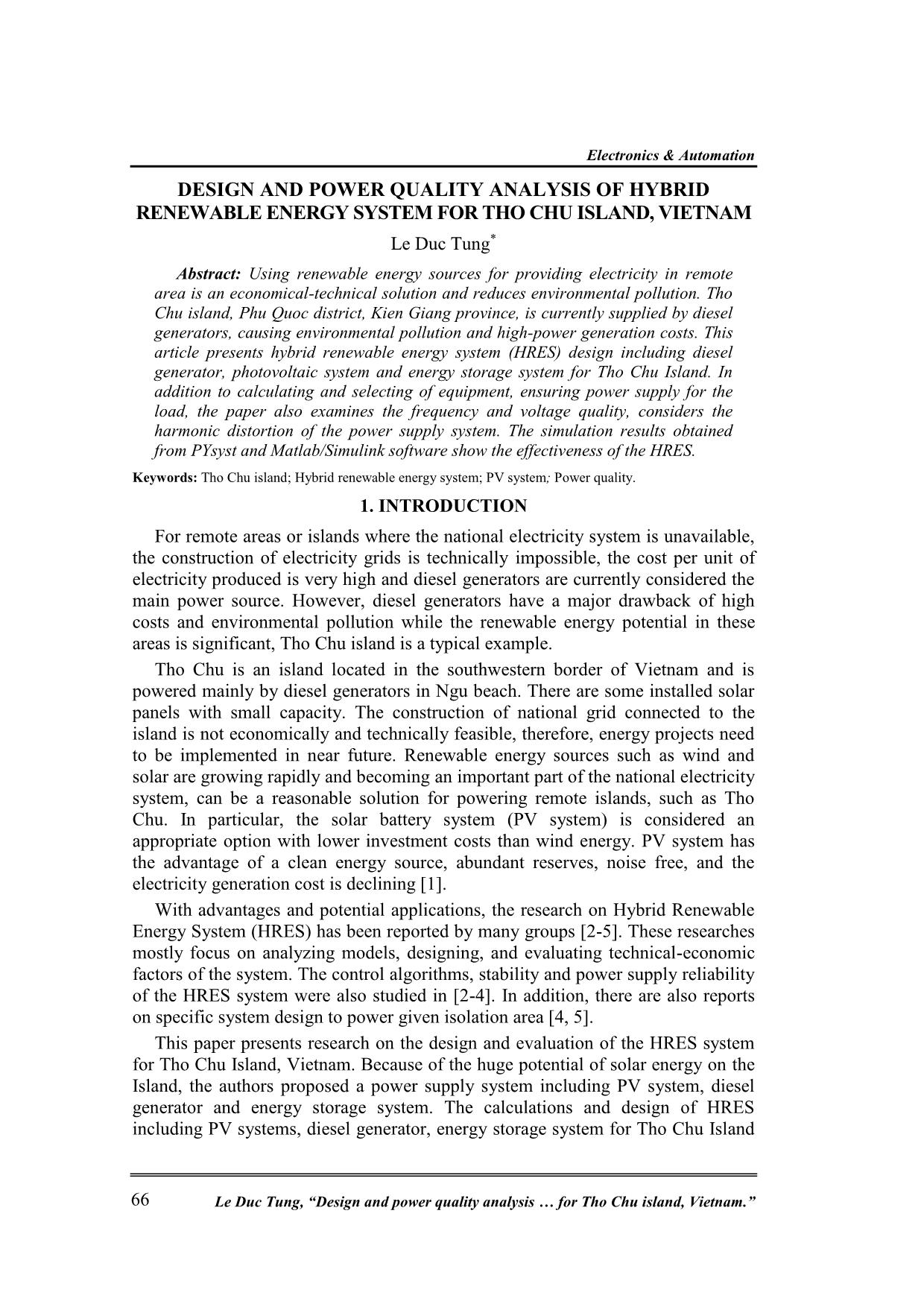
Trang 1
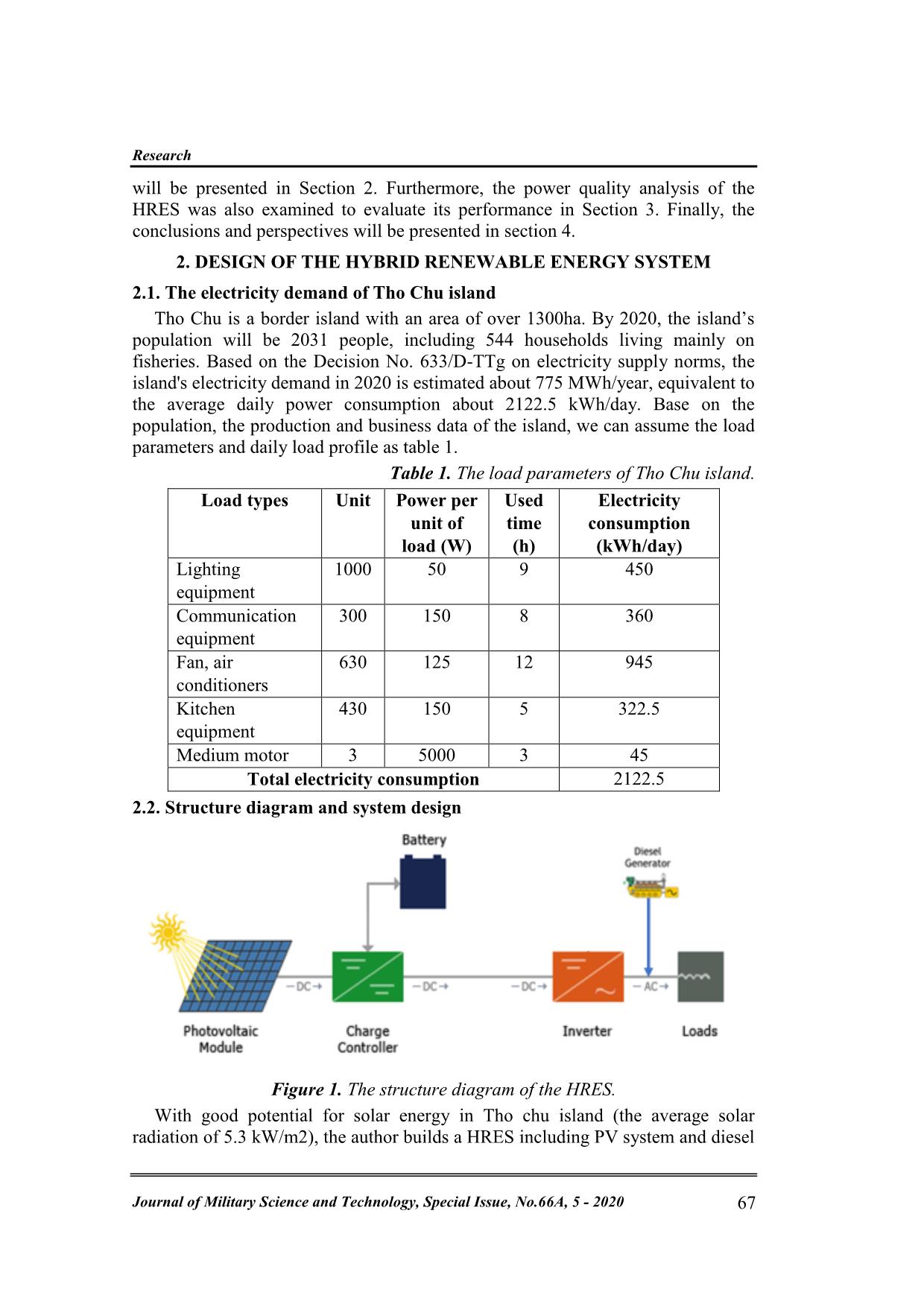
Trang 2
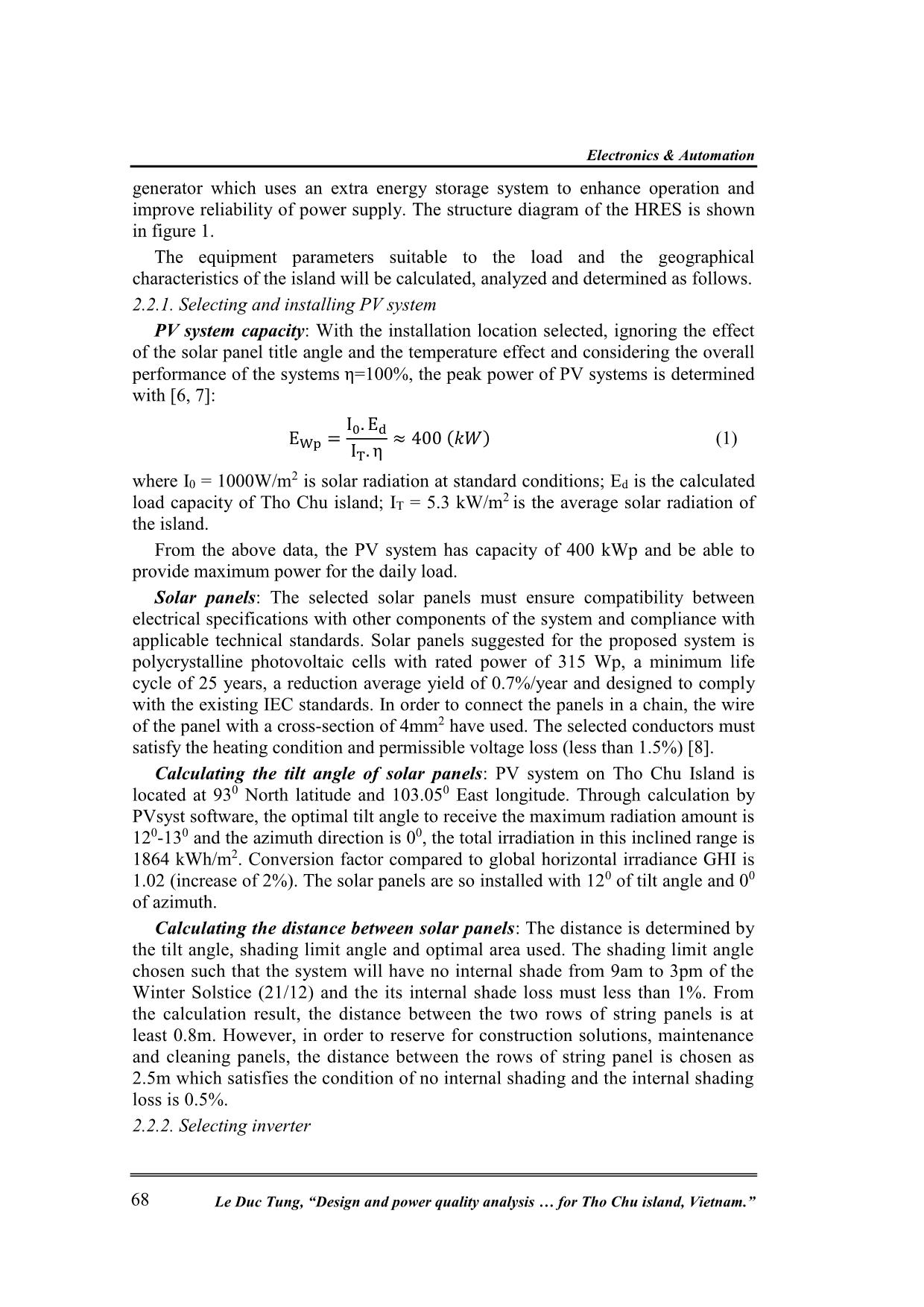
Trang 3
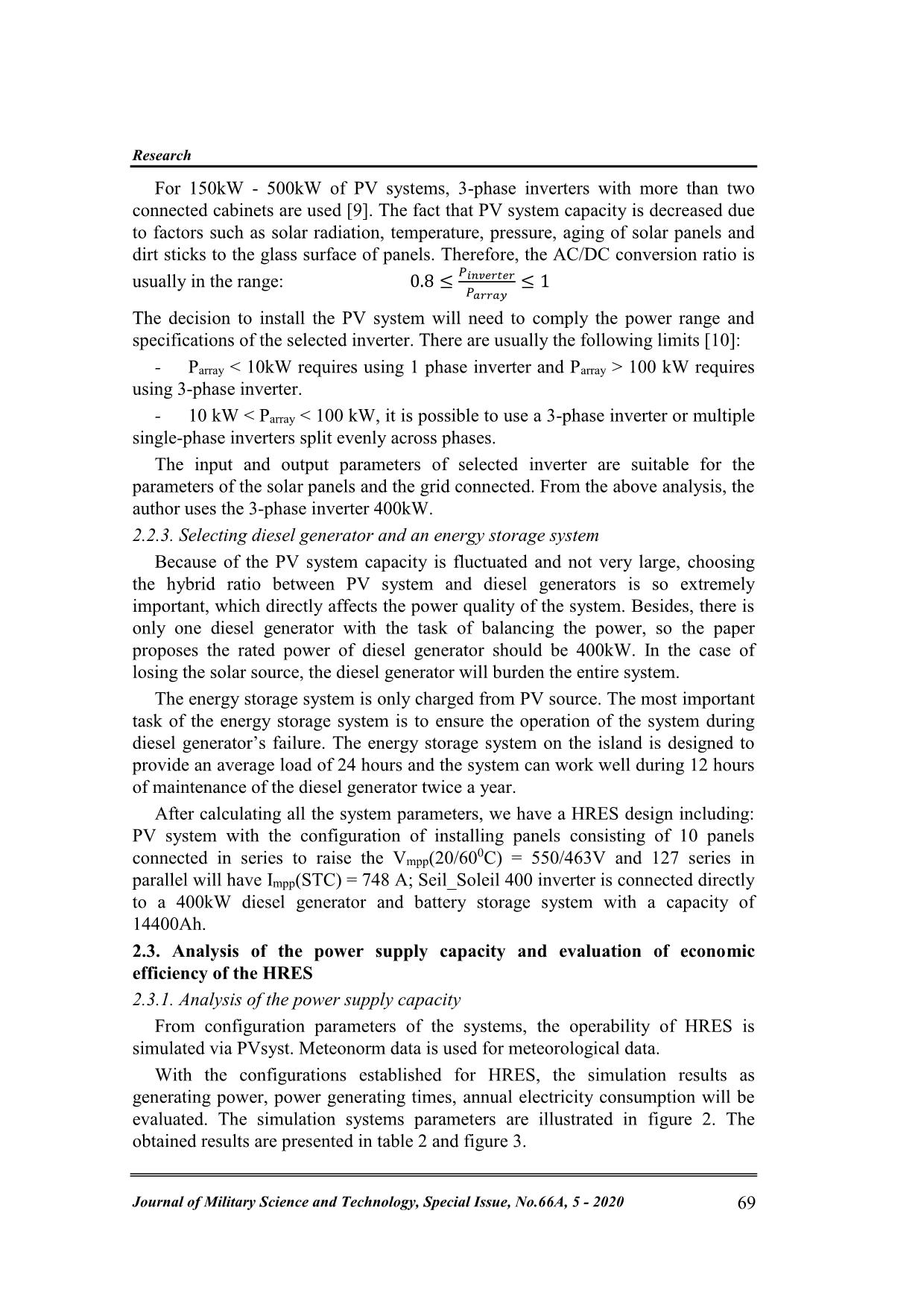
Trang 4
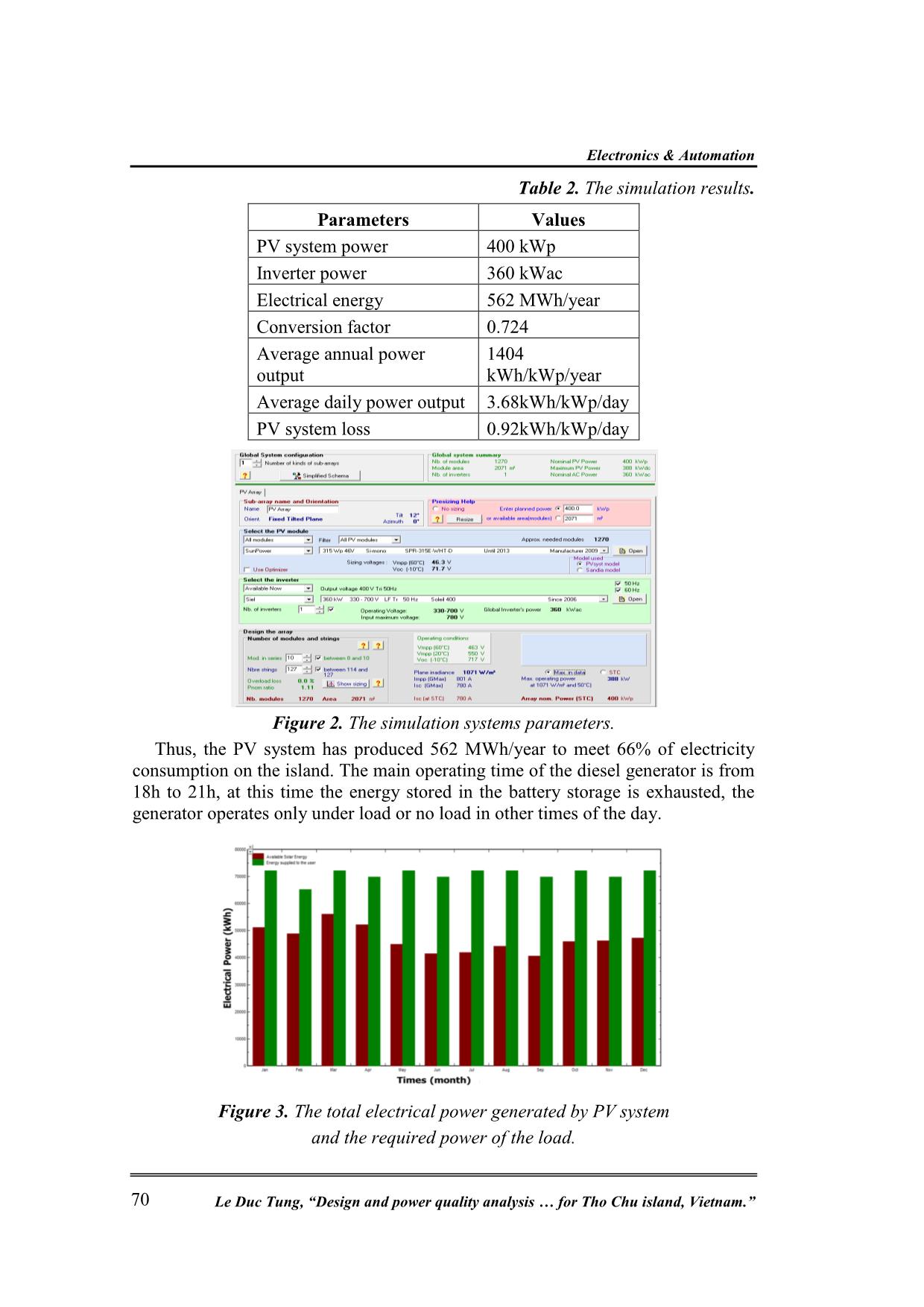
Trang 5
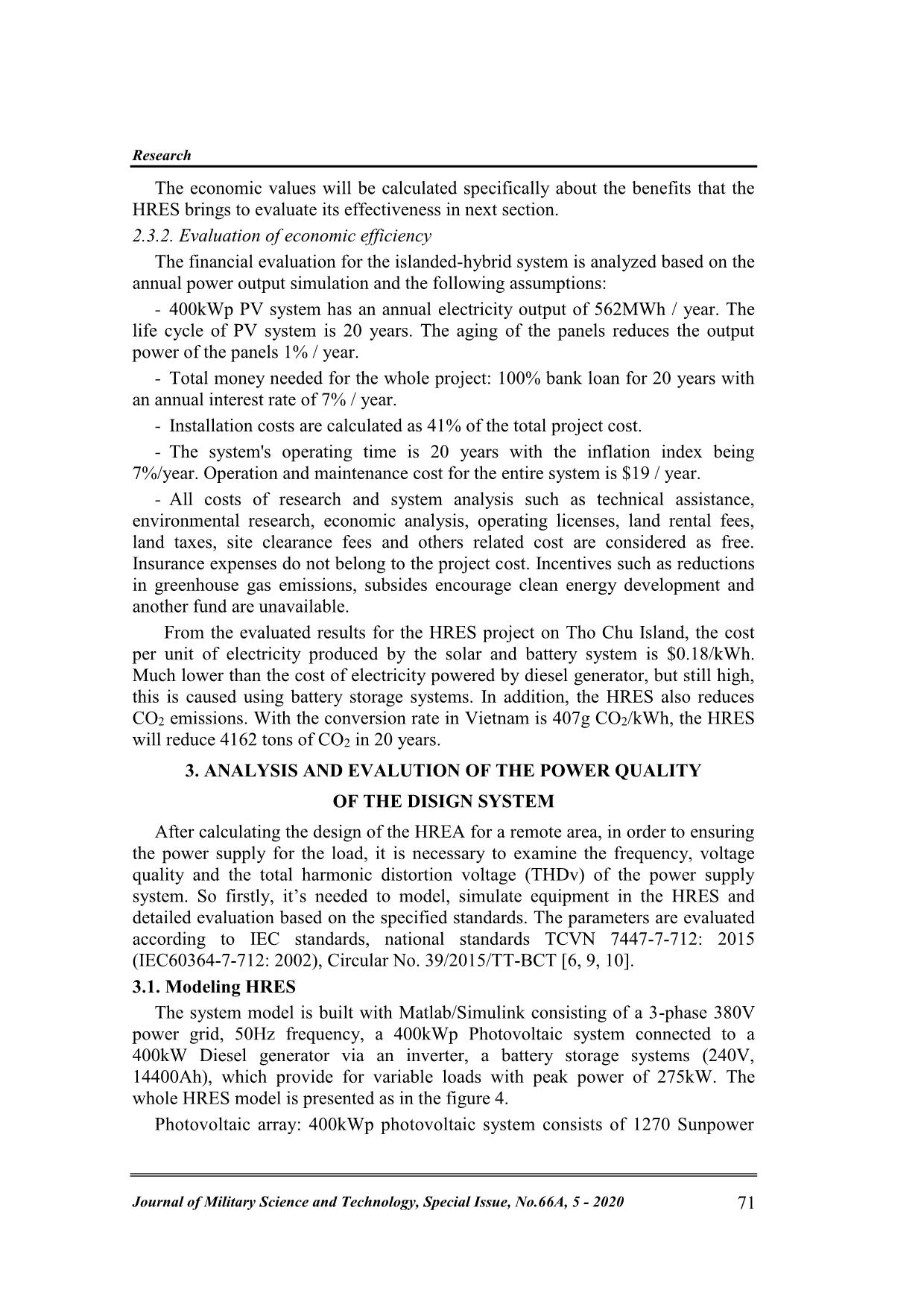
Trang 6
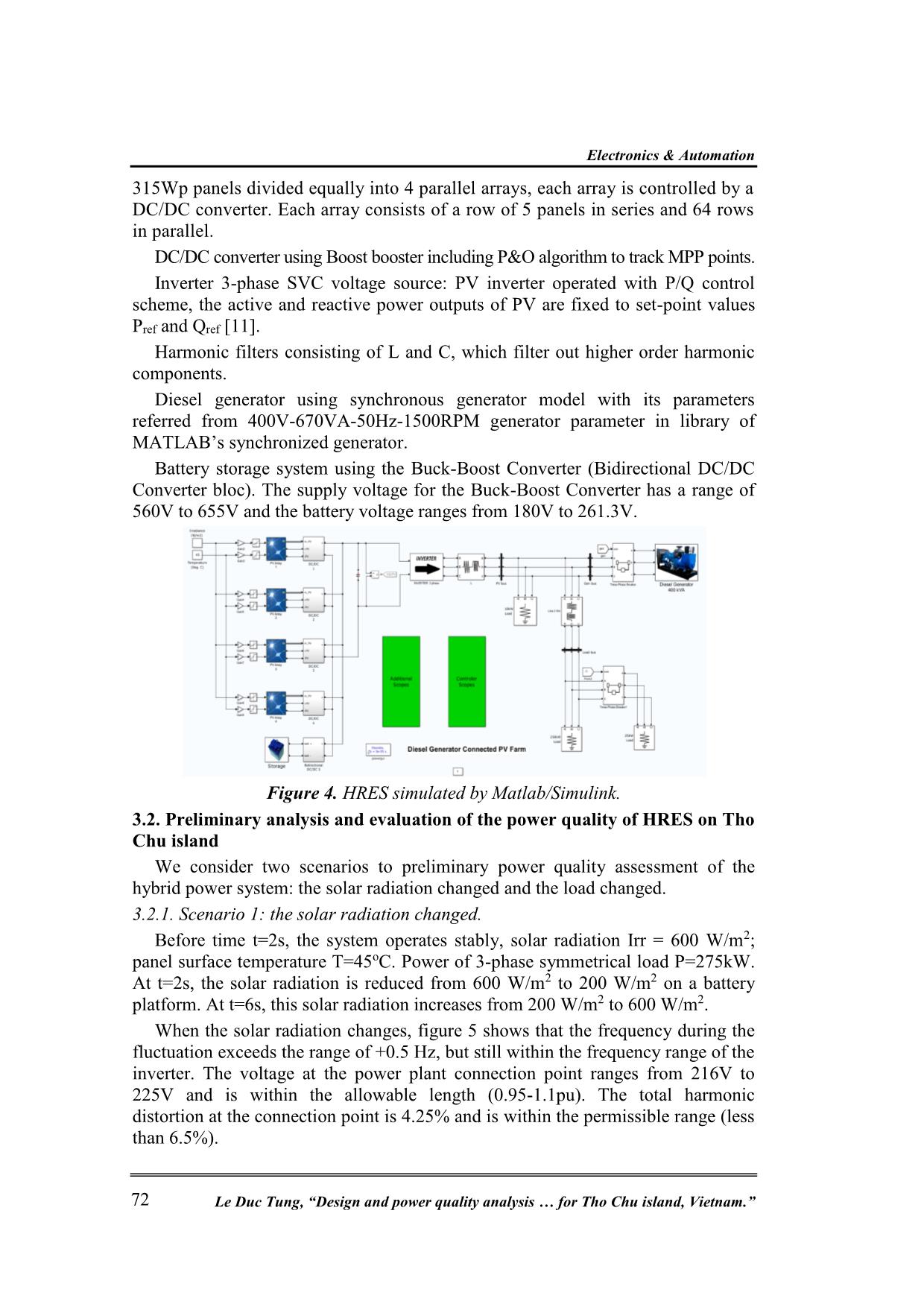
Trang 7
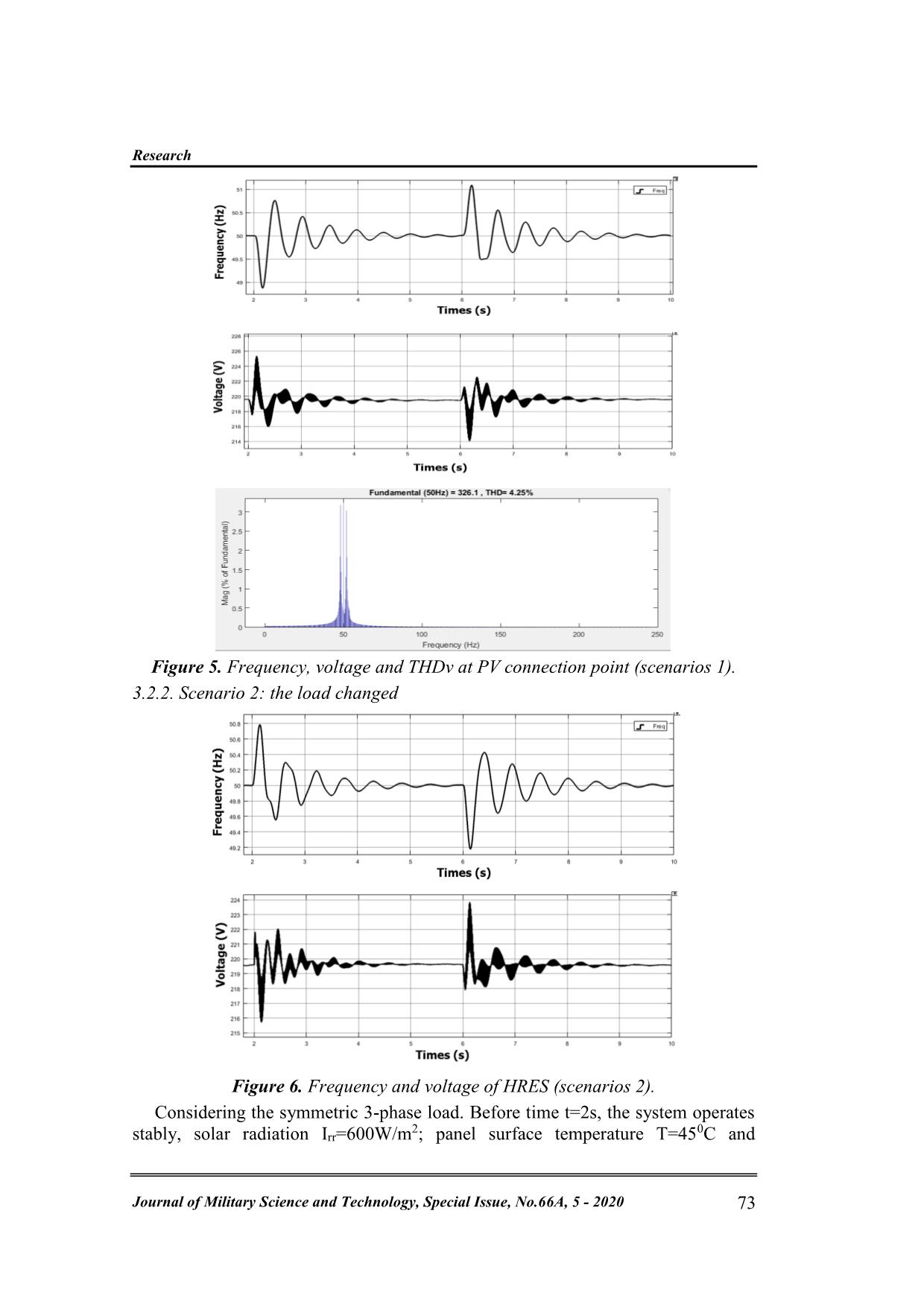
Trang 8
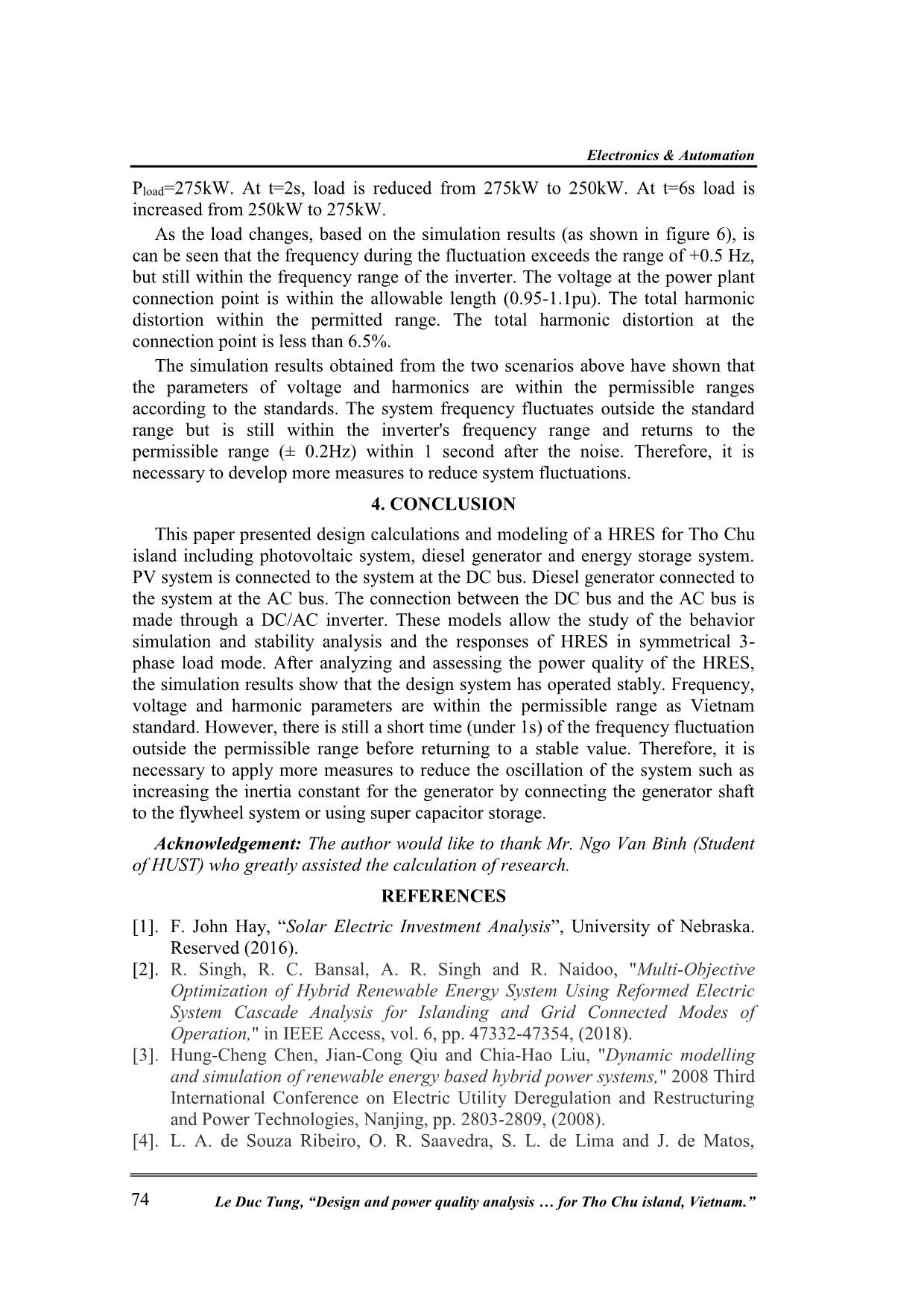
Trang 9
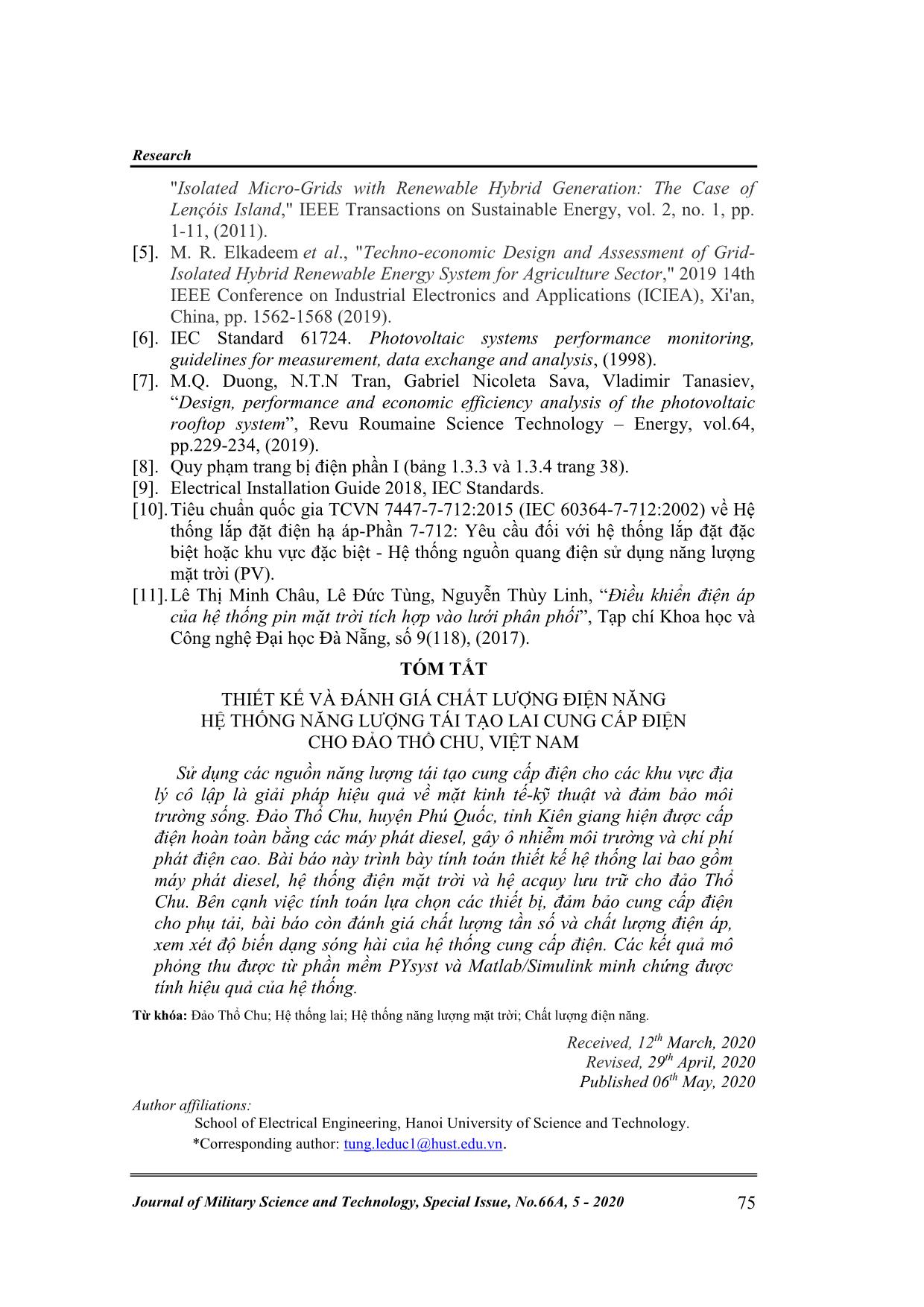
Trang 10
Tóm tắt nội dung tài liệu: Design and power quality analysis of hybrid renewable energy system for Tho Chu island, Viet Nam
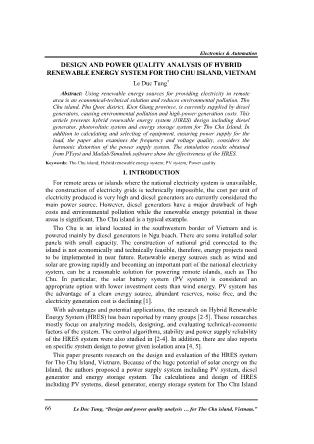
due to factors such as solar radiation, temperature, pressure, aging of solar panels and dirt sticks to the glass surface of panels. Therefore, the AC/DC conversion ratio is usually in the range: 0.8 ≤ 𝑃𝑖𝑛𝑣𝑒𝑟𝑡𝑒𝑟 𝑃𝑎𝑟𝑟𝑎𝑦 ≤ 1 The decision to install the PV system will need to comply the power range and specifications of the selected inverter. There are usually the following limits [10]: - Parray 100 kW requires using 3-phase inverter. - 10 kW < Parray < 100 kW, it is possible to use a 3-phase inverter or multiple single-phase inverters split evenly across phases. The input and output parameters of selected inverter are suitable for the parameters of the solar panels and the grid connected. From the above analysis, the author uses the 3-phase inverter 400kW. 2.2.3. Selecting diesel generator and an energy storage system Because of the PV system capacity is fluctuated and not very large, choosing the hybrid ratio between PV system and diesel generators is so extremely important, which directly affects the power quality of the system. Besides, there is only one diesel generator with the task of balancing the power, so the paper proposes the rated power of diesel generator should be 400kW. In the case of losing the solar source, the diesel generator will burden the entire system. The energy storage system is only charged from PV source. The most important task of the energy storage system is to ensure the operation of the system during diesel generator’s failure. The energy storage system on the island is designed to provide an average load of 24 hours and the system can work well during 12 hours of maintenance of the diesel generator twice a year. After calculating all the system parameters, we have a HRES design including: PV system with the configuration of installing panels consisting of 10 panels connected in series to raise the Vmpp(20/60 0C) = 550/463V and 127 series in parallel will have Impp(STC) = 748 A; Seil_Soleil 400 inverter is connected directly to a 400kW diesel generator and battery storage system with a capacity of 14400Ah. 2.3. Analysis of the power supply capacity and evaluation of economic efficiency of the HRES 2.3.1. Analysis of the power supply capacity From configuration parameters of the systems, the operability of HRES is simulated via PVsyst. Meteonorm data is used for meteorological data. With the configurations established for HRES, the simulation results as generating power, power generating times, annual electricity consumption will be evaluated. The simulation systems parameters are illustrated in figure 2. The obtained results are presented in table 2 and figure 3. Electronics & Automation Le Duc Tung, “Design and power quality analysis for Tho Chu island, Vietnam.” 70 Table 2. The simulation results. Parameters Values PV system power 400 kWp Inverter power 360 kWac Electrical energy 562 MWh/year Conversion factor 0.724 Average annual power output 1404 kWh/kWp/year Average daily power output 3.68kWh/kWp/day PV system loss 0.92kWh/kWp/day Figure 2. The simulation systems parameters. Thus, the PV system has produced 562 MWh/year to meet 66% of electricity consumption on the island. The main operating time of the diesel generator is from 18h to 21h, at this time the energy stored in the battery storage is exhausted, the generator operates only under load or no load in other times of the day. Figure 3. The total electrical power generated by PV system and the required power of the load. Research Journal of Military Science and Technology, Special Issue, No.66A, 5 - 2020 71 The economic values will be calculated specifically about the benefits that the HRES brings to evaluate its effectiveness in next section. 2.3.2. Evaluation of economic efficiency The financial evaluation for the islanded-hybrid system is analyzed based on the annual power output simulation and the following assumptions: - 400kWp PV system has an annual electricity output of 562MWh / year. The life cycle of PV system is 20 years. The aging of the panels reduces the output power of the panels 1% / year. - Total money needed for the whole project: 100% bank loan for 20 years with an annual interest rate of 7% / year. - Installation costs are calculated as 41% of the total project cost. - The system's operating time is 20 years with the inflation index being 7%/year. Operation and maintenance cost for the entire system is $19 / year. - All costs of research and system analysis such as technical assistance, environmental research, economic analysis, operating licenses, land rental fees, land taxes, site clearance fees and others related cost are considered as free. Insurance expenses do not belong to the project cost. Incentives such as reductions in greenhouse gas emissions, subsides encourage clean energy development and another fund are unavailable. From the evaluated results for the HRES project on Tho Chu Island, the cost per unit of electricity produced by the solar and battery system is $0.18/kWh. Much lower than the cost of electricity powered by diesel generator, but still high, this is caused using battery storage systems. In addition, the HRES also reduces CO2 emissions. With the conversion rate in Vietnam is 407g CO2/kWh, the HRES will reduce 4162 tons of CO2 in 20 years. 3. ANALYSIS AND EVALUTION OF THE POWER QUALITY OF THE DISIGN SYSTEM After calculating the design of the HREA for a remote area, in order to ensuring the power supply for the load, it is necessary to examine the frequency, voltage quality and the total harmonic distortion voltage (THDv) of the power supply system. So firstly, it’s needed to model, simulate equipment in the HRES and detailed evaluation based on the specified standards. The parameters are evaluated according to IEC standards, national standards TCVN 7447-7-712: 2015 (IEC60364-7-712: 2002), Circular No. 39/2015/TT-BCT [6, 9, 10]. 3.1. Modeling HRES The system model is built with Matlab/Simulink consisting of a 3-phase 380V power grid, 50Hz frequency, a 400kWp Photovoltaic system connected to a 400kW Diesel generator via an inverter, a battery storage systems (240V, 14400Ah), which provide for variable loads with peak power of 275kW. The whole HRES model is presented as in the figure 4. Photovoltaic array: 400kWp photovoltaic system consists of 1270 Sunpower Electronics & Automation Le Duc Tung, “Design and power quality analysis for Tho Chu island, Vietnam.” 72 315Wp panels divided equally into 4 parallel arrays, each array is controlled by a DC/DC converter. Each array consists of a row of 5 panels in series and 64 rows in parallel. DC/DC converter using Boost booster including P&O algorithm to track MPP points. Inverter 3-phase SVC voltage source: PV inverter operated with P/Q control scheme, the active and reactive power outputs of PV are fixed to set-point values Pref and Qref [11]. Harmonic filters consisting of L and C, which filter out higher order harmonic components. Diesel generator using synchronous generator model with its parameters referred from 400V-670VA-50Hz-1500RPM generator parameter in library of MATLAB’s synchronized generator. Battery storage system using the Buck-Boost Converter (Bidirectional DC/DC Converter bloc). The supply voltage for the Buck-Boost Converter has a range of 560V to 655V and the battery voltage ranges from 180V to 261.3V. Figure 4. HRES simulated by Matlab/Simulink. 3.2. Preliminary analysis and evaluation of the power quality of HRES on Tho Chu island We consider two scenarios to preliminary power quality assessment of the hybrid power system: the solar radiation changed and the load changed. 3.2.1. Scenario 1: the solar radiation changed. Before time t=2s, the system operates stably, solar radiation Irr = 600 W/m2; panel surface temperature T=45oC. Power of 3-phase symmetrical load P=275kW. At t=2s, the solar radiation is reduced from 600 W/m2 to 200 W/m2 on a battery platform. At t=6s, this solar radiation increases from 200 W/m2 to 600 W/m2. When the solar radiation changes, figure 5 shows that the frequency during the fluctuation exceeds the range of +0.5 Hz, but still within the frequency range of the inverter. The voltage at the power plant connection point ranges from 216V to 225V and is within the allowable length (0.95-1.1pu). The total harmonic distortion at the connection point is 4.25% and is within the permissible range (less than 6.5%). Research Journal of Military Science and Technology, Special Issue, No.66A, 5 - 2020 73 Figure 5. Frequency, voltage and THDv at PV connection point (scenarios 1). 3.2.2. Scenario 2: the load changed Figure 6. Frequency and voltage of HRES (scenarios 2). Considering the symmetric 3-phase load. Before time t=2s, the system operates stably, solar radiation Irr=600W/m 2; panel surface temperature T=450C and Electronics & Automation Le Duc Tung, “Design and power quality analysis for Tho Chu island, Vietnam.” 74 Pload=275kW. At t=2s, load is reduced from 275kW to 250kW. At t=6s load is increased from 250kW to 275kW. As the load changes, based on the simulation results (as shown in figure 6), is can be seen that the frequency during the fluctuation exceeds the range of +0.5 Hz, but still within the frequency range of the inverter. The voltage at the power plant connection point is within the allowable length (0.95-1.1pu). The total harmonic distortion within the permitted range. The total harmonic distortion at the connection point is less than 6.5%. The simulation results obtained from the two scenarios above have shown that the parameters of voltage and harmonics are within the permissible ranges according to the standards. The system frequency fluctuates outside the standard range but is still within the inverter's frequency range and returns to the permissible range (± 0.2Hz) within 1 second after the noise. Therefore, it is necessary to develop more measures to reduce system fluctuations. 4. CONCLUSION This paper presented design calculations and modeling of a HRES for Tho Chu island including photovoltaic system, diesel generator and energy storage system. PV system is connected to the system at the DC bus. Diesel generator connected to the system at the AC bus. The connection between the DC bus and the AC bus is made through a DC/AC inverter. These models allow the study of the behavior simulation and stability analysis and the responses of HRES in symmetrical 3- phase load mode. After analyzing and assessing the power quality of the HRES, the simulation results show that the design system has operated stably. Frequency, voltage and harmonic parameters are within the permissible range as Vietnam standard. However, there is still a short time (under 1s) of the frequency fluctuation outside the permissible range before returning to a stable value. Therefore, it is necessary to apply more measures to reduce the oscillation of the system such as increasing the inertia constant for the generator by connecting the generator shaft to the flywheel system or using super capacitor storage. Acknowledgement: The author would like to thank Mr. Ngo Van Binh (Student of HUST) who greatly assisted the calculation of research. REFERENCES [1]. F. John Hay, “Solar Electric Investment Analysis”, University of Nebraska. Reserved (2016). [2]. R. Singh, R. C. Bansal, A. R. Singh and R. Naidoo, "Multi-Objective Optimization of Hybrid Renewable Energy System Using Reformed Electric System Cascade Analysis for Islanding and Grid Connected Modes of Operation," in IEEE Access, vol. 6, pp. 47332-47354, (2018). [3]. Hung-Cheng Chen, Jian-Cong Qiu and Chia-Hao Liu, "Dynamic modelling and simulation of renewable energy based hybrid power systems," 2008 Third International Conference on Electric Utility Deregulation and Restructuring and Power Technologies, Nanjing, pp. 2803-2809, (2008). [4]. L. A. de Souza Ribeiro, O. R. Saavedra, S. L. de Lima and J. de Matos, Research Journal of Military Science and Technology, Special Issue, No.66A, 5 - 2020 75 "Isolated Micro-Grids with Renewable Hybrid Generation: The Case of Lençóis Island," IEEE Transactions on Sustainable Energy, vol. 2, no. 1, pp. 1-11, (2011). [5]. M. R. Elkadeem et al., "Techno-economic Design and Assessment of Grid- Isolated Hybrid Renewable Energy System for Agriculture Sector," 2019 14th IEEE Conference on Industrial Electronics and Applications (ICIEA), Xi'an, China, pp. 1562-1568 (2019). [6]. IEC Standard 61724. Photovoltaic systems performance monitoring, guidelines for measurement, data exchange and analysis, (1998). [7]. M.Q. Duong, N.T.N Tran, Gabriel Nicoleta Sava, Vladimir Tanasiev, “Design, performance and economic efficiency analysis of the photovoltaic rooftop system”, Revu Roumaine Science Technology – Energy, vol.64, pp.229-234, (2019). [8]. Quy phạm trang bị điện phần I (bảng 1.3.3 và 1.3.4 trang 38). [9]. Electrical Installation Guide 2018, IEC Standards. [10]. Tiêu chuẩn quốc gia TCVN 7447-7-712:2015 (IEC 60364-7-712:2002) về Hệ thống lắp đặt điện hạ áp-Phần 7-712: Yêu cầu đối với hệ thống lắp đặt đặc biệt hoặc khu vực đặc biệt - Hệ thống nguồn quang điện sử dụng năng lượng mặt trời (PV). [11]. Lê Thị Minh Châu, Lê Đức Tùng, Nguyễn Thùy Linh, “Điều khiển điện áp của hệ thống pin mặt trời tích hợp vào lưới phân phối”, Tạp chí Khoa học và Công nghệ Đại học Đà Nẵng, số 9(118), (2017). TÓM TẮT THIẾT KẾ VÀ ĐÁNH GIÁ CHẤT LƯỢNG ĐIỆN NĂNG HỆ THỐNG NĂNG LƯỢNG TÁI TẠO LAI CUNG CẤP ĐIỆN CHO ĐẢO THỔ CHU, VIỆT NAM Sử dụng các nguồn năng lượng tái tạo cung cấp điện cho các khu vực địa lý cô lập là giải pháp hiệu quả về mặt kinh tế-kỹ thuật và đảm bảo môi trường sống. Đảo Thổ Chu, huyện Phú Quốc, tỉnh Kiên giang hiện được cấp điện hoàn toàn bằng các máy phát diesel, gây ô nhiễm môi trường và chí phí phát điện cao. Bài báo này trình bày tính toán thiết kế hệ thống lai bao gồm máy phát diesel, hệ thống điện mặt trời và hệ acquy lưu trữ cho đảo Thổ Chu. Bên cạnh việc tính toán lựa chọn các thiết bị, đảm bảo cung cấp điện cho phụ tải, bài báo còn đánh giá chất lượng tần số và chất lượng điện áp, xem xét độ biến dạng sóng hài của hệ thống cung cấp điện. Các kết quả mô phỏng thu được từ phần mềm PYsyst và Matlab/Simulink minh chứng được tính hiệu quả của hệ thống. Từ khóa: Đảo Thổ Chu; Hệ thống lai; Hệ thống năng lượng mặt trời; Chất lượng điện năng. Received, 12th March, 2020 Revised, 29th April, 2020 Published 06th May, 2020 Author affiliations: School of Electrical Engineering, Hanoi University of Science and Technology. *Corresponding author: tung.leduc1@hust.edu.vn.
File đính kèm:
 design_and_power_quality_analysis_of_hybrid_renewable_energy.pdf
design_and_power_quality_analysis_of_hybrid_renewable_energy.pdf

